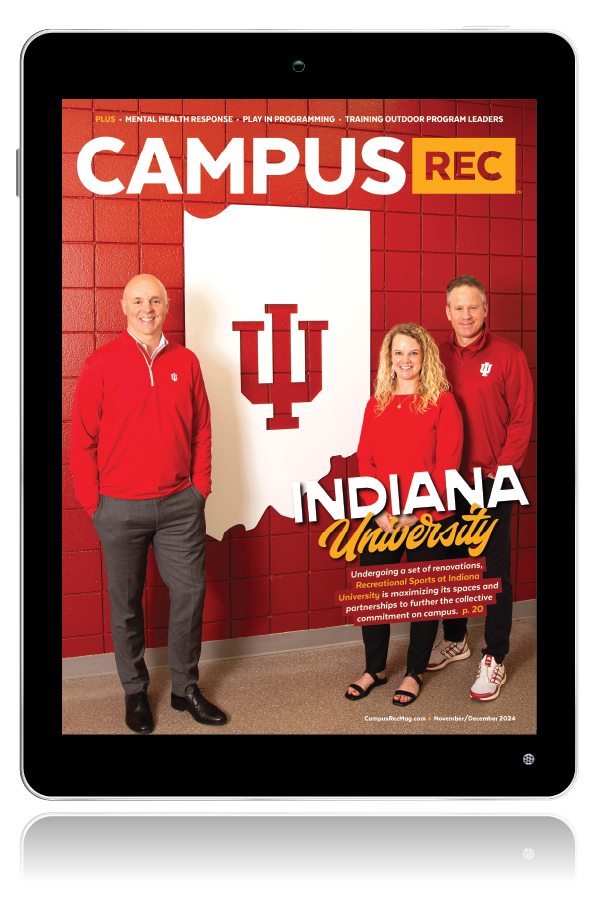Risk management is critical in campus rec aquatics. With numerous hazards in and around a pool area — from deep water to slippery floors to equipment stacked against the walls — your staff and students alike need aware of and educated on aquatics risk management procedures.
Nova Southeastern University in Fort Lauderdale, Florida, has one of the top aquatics facilities in the industry and takes aquatics risk management very seriously. With a dedicated approach to education of both staff and users, Nova Southeastern is prepared for virtually every emergency scenario.
For a closer look at Nova Southeastern’s aquatics risk management strategy, we spoke to Tec Clark, the school’s director for aquatics and scuba diving:
CR: What are some of your department’s best practices for aquatics risk management?
TC: We want to create a culture of safety, and that culture of safety comes from a risk management mindset. We oversee aquatics and scuba activities — they’re both under our umbrella. What we do in those two areas, because they’re both high-risk areas and require supervision, is provide necessary education. The similarities are so much that they’re lumped together. We have an approach to risk management that has three steps. The first is asking what could go wrong. What can happen in this pool today? What can happen at this lake today? The second step is to address mitigating those risks. We can’t guarantee complete safety — we’re just minimizing risk. The third step is all about reactions. How do you respond if something goes wrong? If it does, do we know how to handle it? When we take that three-step approach to anything we do in aquatics or scuba, that means we’re very prepared for what can go wrong.
CR: How do you train your aquatics staff in risk management?
TC: It starts at the beginning with hiring. A lot of people really just say they need some bodies in seats and then train them up. Maturity is big for us. Once we’ve gotten that kind of person who’s into our culture of safety and risk management, it’s easy. In our in-service trainings we aren’t afraid to pull out the AED. When that happens an alarm will scream — research has shown when first responders are coming to a scene, the more noises are going off, the higher the heart rate goes, along with a more exacerbated adrenaline rush. If we don’t train this way, they’re going to have an even greater adrenaline rush when they arrive on a scene that can actually hinder their performance in a rescue. We prep them by saying we’ll make it as realistic as possible. When it blasts in their faces the first and second times, it’s expected. When we expect something, we keep calm — we know it’s coming and it won’t be a surprise. That’s how we handle every element of a rescue.
When we have near-fatal drownings we often see the individual will produce a lot of what is called “sputum” or “froth,” and this can be tinted with blood or foamy white, depending on what has gone into the individual. This is very different than what we learn in CPR courses. With baking soda and vinegar, we do something like that to the lungs of our mannequin. This is also an awesome way to see how the pocket mask can protect the guard from blood borne pathogens that might come out with bodily fluids. Bodily fluids, even vomit, are so prevalent in aquatic emergencies — that’s why we’ve come up with this method.
CR: What role can student staff and participants play in aquatics risk management? How do you educate them in this area?
TC: We’ve got a lot of student employees who tend to be equipped differently than other employees because they think differently. They’re talking to their fellow students about risk — neat engagements and conversations are happening between them. It’s become part of who they are because they’ve had certain skillsets developed, so they’re thinking about risk management all the time. It ends up getting shared with others. By educating our staff, we have many opportunities where someone comes along, doesn’t understand a rule, and ends up disagreeing with it or breaking it, which allows us to educate them. We want for people to understand why it says what it says in our rules and in the health code. At the professional level we are always looking for the people who are educators. We want someone who not only has rock star credentials, but who embraces those credentials and is a really dynamic teacher. That helps us educate people on rules, and that’s how they get behind them. That’s part of what we do in risk management — educate on rules that are often questioned.










